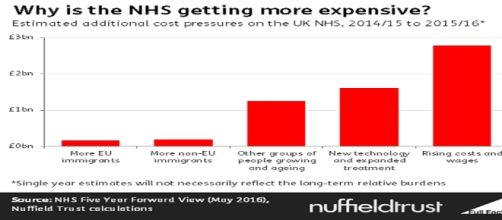This week saw a devastating cyber-attack on the NHS. This now has sparked a row over funding for the health service. The Conservatives constantly claim that they have spent more money on the NHS in ‘real-terms’ yet Labour, Liberal Democrats, SNP plus other political parties claim that funding has been cut. The NHS has been facing severe financial pressure for the last few years and two-thirds of NHS Trusts, who provide secondary care for patients referred there by a GP, are in the red.
The cyber-attack has only sought to highlight the pressures the NHS is facing over funding.
But what is the truth of funding for the health service? The budget set aside has been protected, however, it is more complex than a singular amount set aside for the NHS.
NHS funding and costs
The pressure on the NHS service has been largely due to ageing and rising population, with the older generation generally requiring more care and thus costing the service more. Current spending on the NHS is approximately £120 billion and is due to rise by around £5 billion by 2020. In 2010, David Cameron pledged to not cut the NHS and in real-terms, the Conservatives have funded the NHS in real-terms, which is the amount spent increased more than the rate of inflation.
However, real-terms funding is just the overall budget of the NHS and where the funding goes is more important.
Firstly, private contracts cost the NHS around £2 billion a year and PFI will cost the NHS £79 billion over 31 years, despite it only costing the private contractors £11.8 billion originally. PFI costs approximately the NHS another £2 billion a year. Also, when George Osbourne became chancellor in 2010, he asked the NHS to find billions in ‘efficiency savings’.
NHS cyber-attack
Health Secretary, Jeremy Hunt, has ignored repeated warnings that the system was outdated and in 2015, cancelled the £5.5 million deal with Microsoft to provide ongoing security with the Windows XP operating system. Since the attack, Jeremy Hunt has gone missing and hasn’t made a public statement for over a week. Jon Ashworth, Shadow Health Minister, wrote “It effectively means that unless individual trusts were willing to pay Microsoft for an extended support deal, since May 2015 their operating systems have been extremely vulnerable to being hacked.”
The letter penned by Ashworth was replied to by Home Secretary, Amber Rudd, rather than Jeremy Hunt.
She said “The malicious actions of the cyber criminals behind this attack have caused considerable distress for those patients who have been affected. There is no evidence that any patient data has been compromised and the NHS has done brilliantly to manage the disruption.”
Questions over funding
This raises even more question marks over NHS funding. NHS England has previously stated that they are facing a £30 billion gap in funding by 2020 and has laid out plans to handle the gap, the most ambitious being finding £22 billion in savings and the other £8 billion being funded by the government. The Nuffield trust said that £8 billion is the ‘bare minimum’ needed to continue care and finding £22 billion in savings would be unprecedented.
This was after the Conservative 2015 manifesto laid out that they would provide £8 billion in funding if the NHS found the rest in savings.
The Conservatives have also said they will provide an extra £10 billion funding for the NHS, however, it is not to be taken at face value. Firstly, the Conservatives have redefined the pot, meaning this would go to NHS England which includes public health, education and training, the overall NHS budget would face a loss of £5 billion. Secondly, executives asked for funding over 5 years, this £10 billion will come over 6 years, meaning they will get less than they asked for each year. The head of NHS England confirmed this and said that the money is at the lowest end of the options the NHS set out.
Current funding levels means that by 2018/19, the amount of money the NHS has isn’t expected to grow at all after taking inflation into account. Experts have repeatedly warned that there “will not be enough to maintain standards of care” and “meet rising demand” or “deliver the transformation outlined in the NHS five year forward view”. This means that without proper funding, the NHS will not be able to upgrade its infrastructure and improve or continue patient care.

